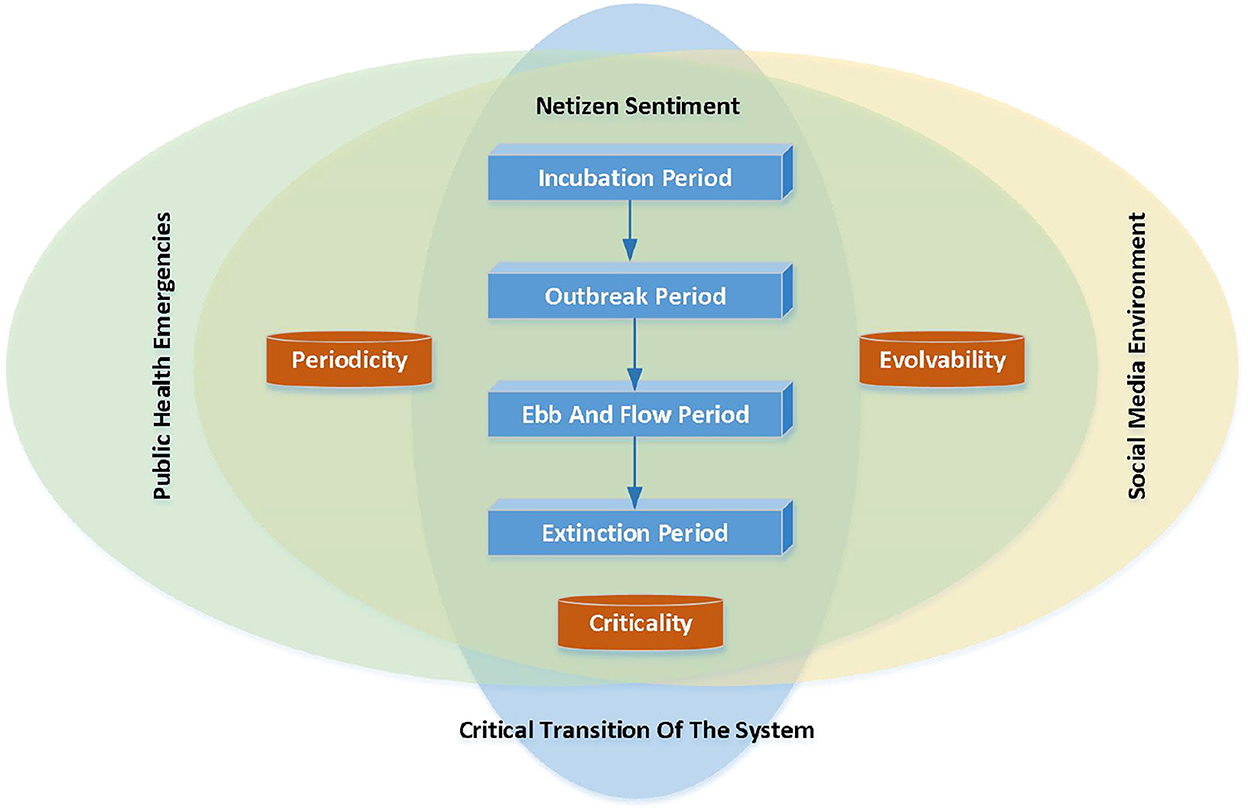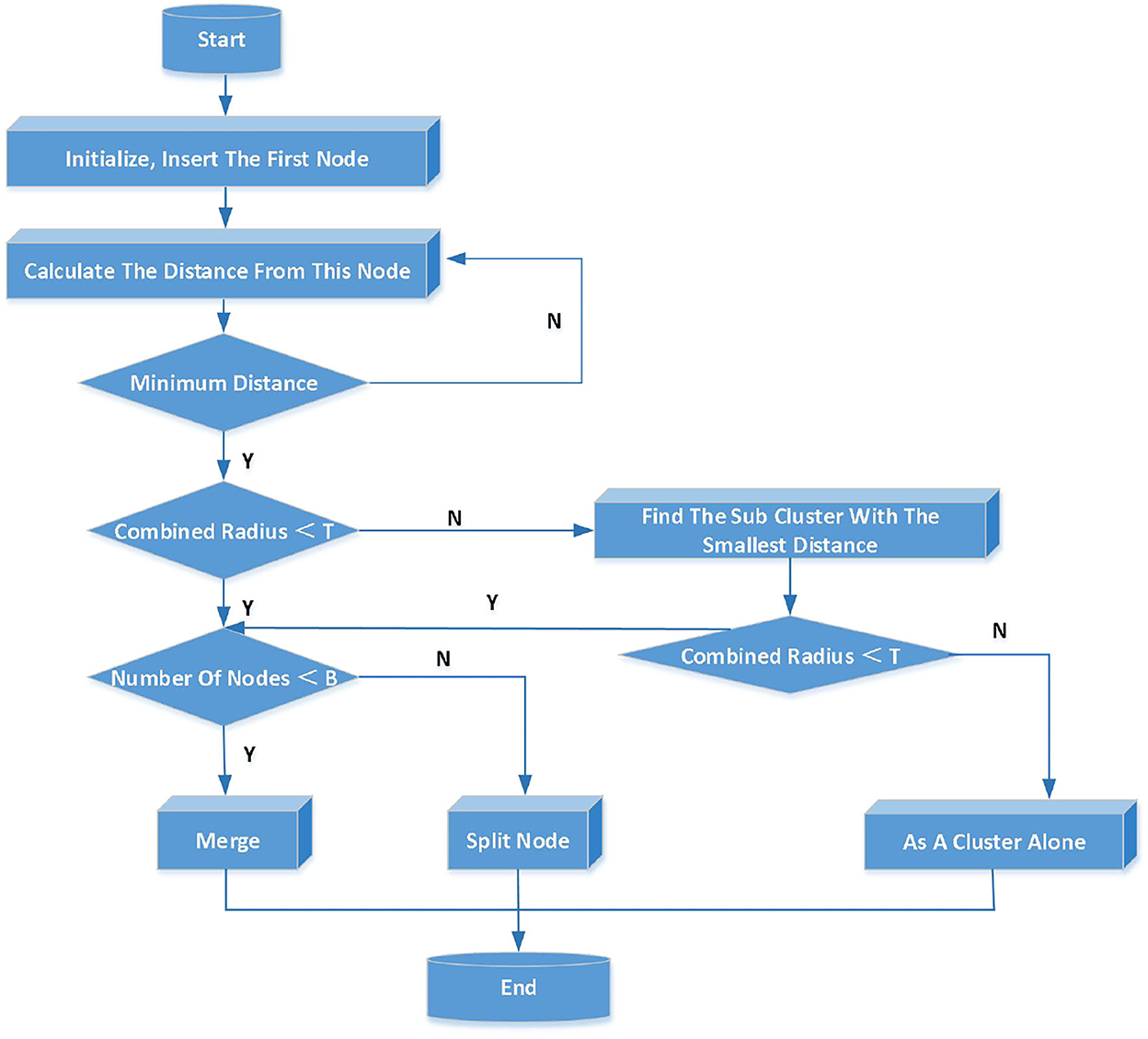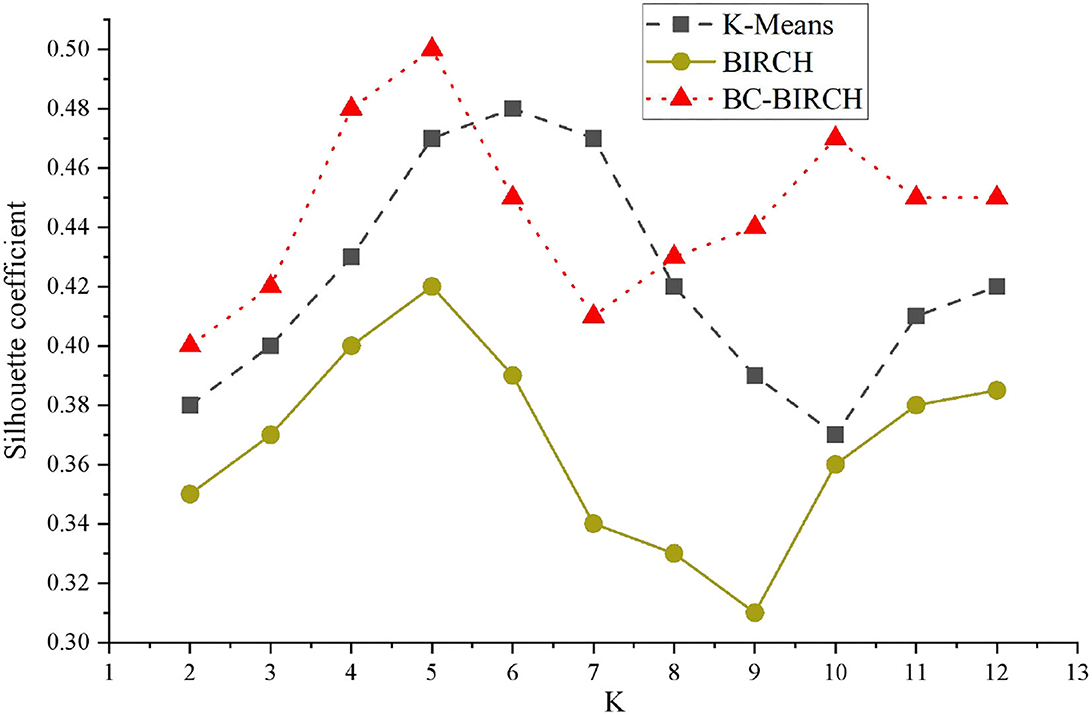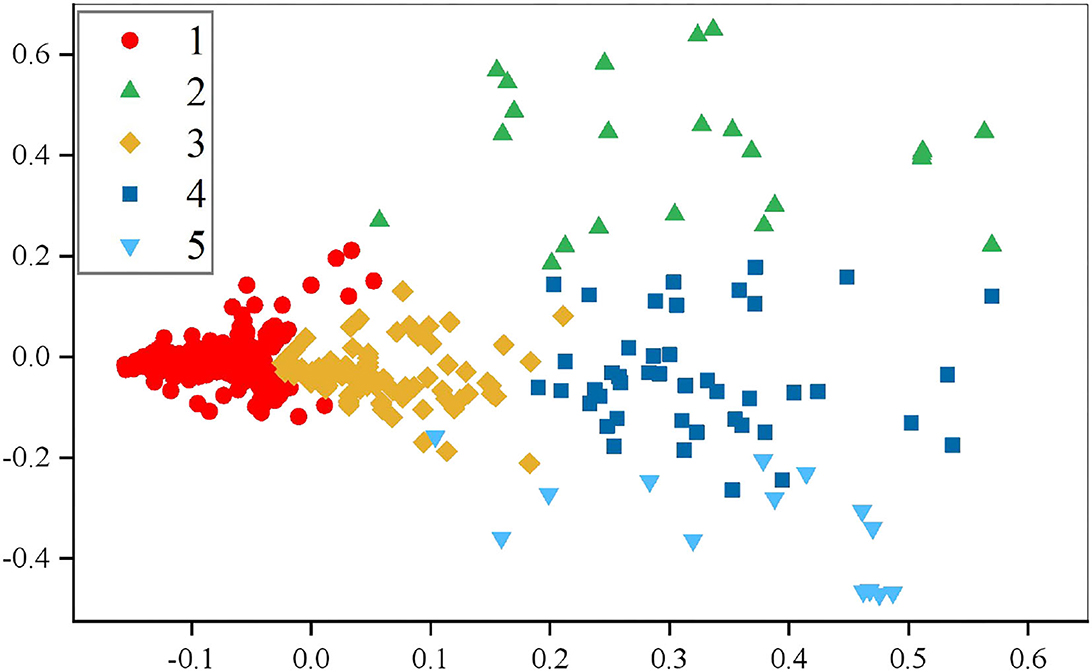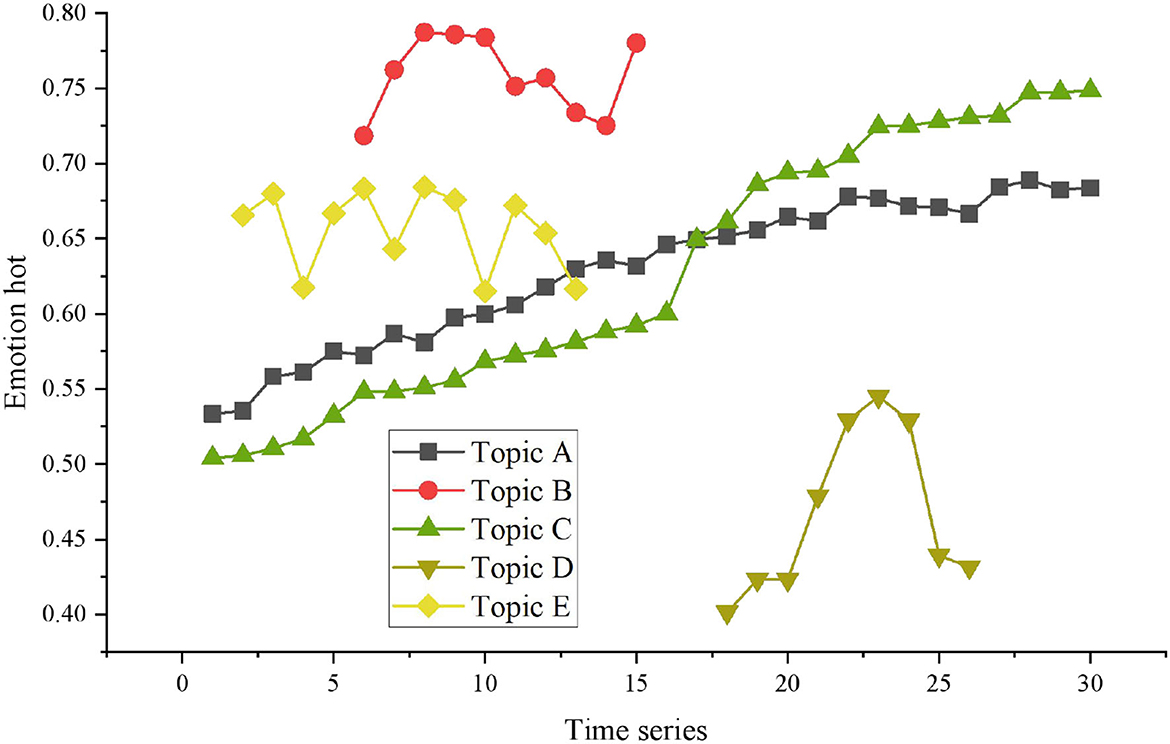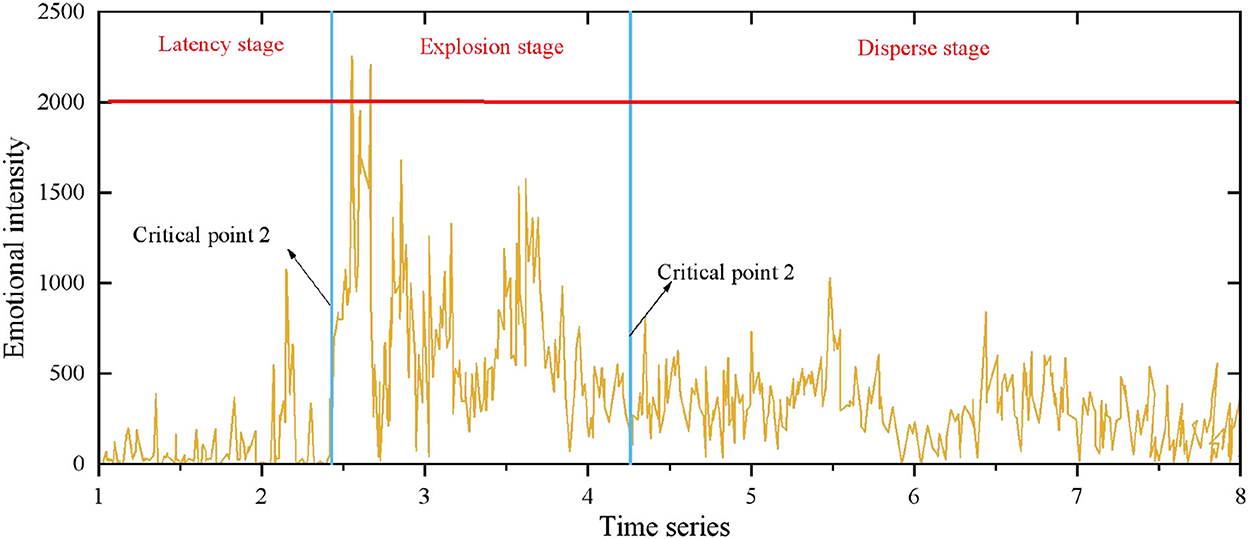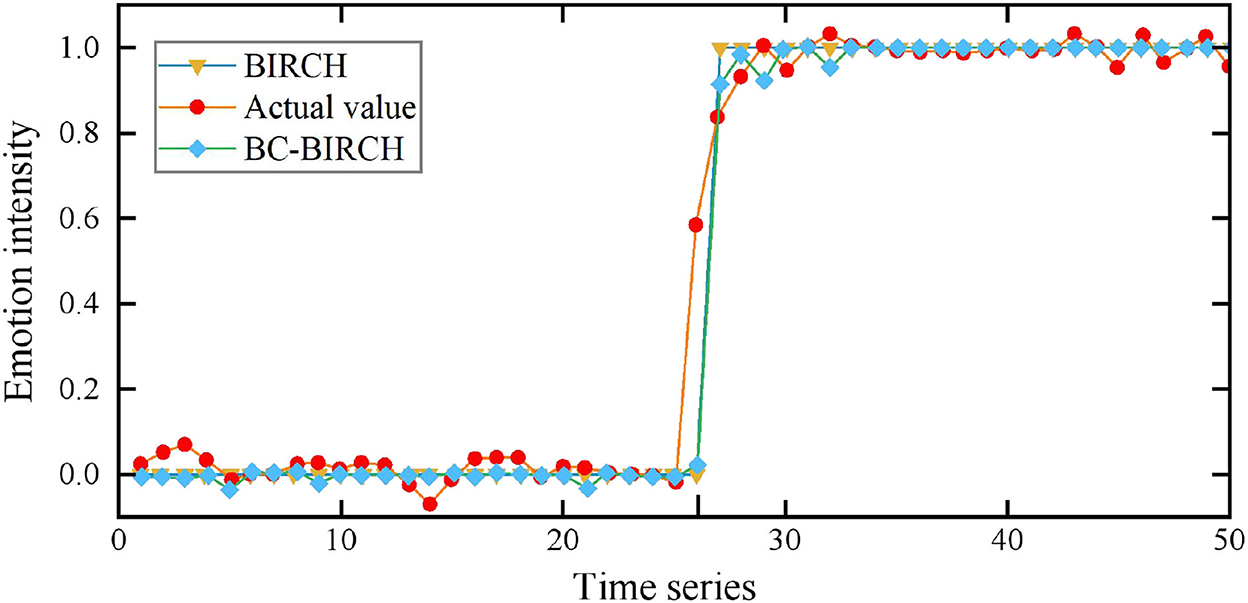- 1Department of Public Security Administration, Hubei University of Police, Wuhan, China
- 2School of Information Engineering, Wuhan College, Wuhan, China
At present, social media have become the main media of network public opinion (PO) dissemination. By analyzing the trend of emotional development in public emergencies, we can explore the evolution law of PO and identify potential risks, which provide decision support for the guidance and control of government management. First, based on the concept of critical points in the complex system, this study established a public sentiment (PS) evolution model under public emergencies and proposed an algorithm to identify the critical points in PS based on microblog data analysis. In addition, the BC-BIRCH algorithm was used to construct a topic clustering model for public emergencies, which improved the effect of topic discovery by merging multiple topic clusters. The evolution of public emergencies was analyzed by calculating the emotional heat value of different topic events. Finally, experimental results showed that the emotion of netizens' fluctuates greatly in the initial stage of PO under different themes. The method used in this paper achieved good results in topic clustering, critical point prediction, and PO evolution analysis of public emergencies. The main contribution of this paper is to analyze the evolution of the internal mechanism of PS and to identify and predict key nodes such as the outbreak and extinction of netizens' sentiment based on data-driven methods so as to provide the basis and support to the government and related media as the main body of prevention and control to respond in advance and guide in time.
Introduction
With the rapid development of social media, especially social information, the original public opinion (PO) of the single and linear networks has gradually developed to show more characteristics, such as wide source, complex content, fast spread, and diverse forms. Similarly, the real-time characteristics of the network ensure the timeliness of data collection and access, while its dynamic nature provides a theoretical basis for dynamic PO monitoring (Zhang and Chen, 2021). The rapid development of natural language processing and artificial intelligence (AI) technologies makes technological implementation for the discovery of online PO feasible.
At present, China's network equipment is rapidly popularized among more user groups, and network security and network PO become the key regulatory objects of government agencies and also aim to improve the quality of network public relation management services. Therefore, how to reasonably use the massive PO data on the internet in combination with a relevant text analysis technology to control PO is an inevitable problem for government agencies in public relation management services (The 13th Five Year Plan for the Construction of National Emergency Response System). As an important PO field and the PO center of many social events, the microblog has attracted the attention of governments at all levels and has increasingly become the main position of network PO governance. The essence of the microblog is a node sharing instant information network, which has the characteristics of instantaneity and sharing. The dynamic information dissemination network composed of the microblog is a dynamic development (Ma, 2022). Research on the social objectives of emergency management in case of major emergencies mainly focuses on the field of PO governance, among which emotion recognition is a hot spot (Zeng and Li, 2022). Accurate and effective identification of public sentiment (PS) is conducive for government departments to grasp the dynamics of PO and to formulate guidance strategies. However, there are still shortcomings in research on the governance of POs in public emergencies. In terms of prediction methods, many scholars developed semantic recognition and algorithms and optimized prediction methods, such as probability graphic pattern (Rui et al., 2017), deep rolling (Rong et al., 2019), damped oscillator model (Dong et al., 2020), and other newly developed models to predict PS, to achieve good prediction results, and to improve the prediction efficiency from different angles and levels. However, existing research on emotion prediction using machine learning algorithms only focuses on data performance or overemphasizes these algorithms. Meanwhile, most PS data obtained by existing research come from the network text, and many adverbs expressing emotional intensity are often ignored, which cannot truly reflect the change of PS. Indeed, the public in different regions have different emotional expression due to the difference in risk perceptions. Text and network information analysis, user behavior prediction, and other models can better explore the potential scale of network PO data and more accurately predict the emotional changes of users on PO topics so that relevant institutions can more effectively monitor the topic trend of network PO and correctly guide users to regulate their behavior on the network. Indeed, the public in different regions have different emotional expressions due to the difference in risk perception (Zeng et al., 2022).
In public emergencies, it is important to understand how to analyze the evolution of the internal mechanism of PS and to identify and predict the outbreak and decline of netizens' emotions based on data-driven method, to provide the basis and support for the government and relevant media as the main body of prevention and control to respond in advance and guide in time. Therefore, based on the concept of critical points in complex systems, this study combined the critical transition theories in the field of complex systems and established a PS evolution model under public emergencies, which analyzes the evolution and development stages of PS in public emergencies through the microblog text data.
Literature review
Emotional analysis
For some people, the expression of a variety of views is also the phenomenon of diversity. Everyone's expression differ in certain ways, and these differences are a result of different life experiences, different family environments, and diverse educational backgrounds. Emotional analysis on Twitter has achieved some progress and research results. Ruz et al. (2020) proposed a Bayesian factor measurement method and conducted experiments on two Spanish data sets. The results showed that, in comparison with the support vector machine and random forest, the Bayesian factor measurement method can solve emotional analysis problems (Ruz et al., 2020). Hassan conducted an automated web recycling through RStudio, collecting data on cryptocurrency tweets, extracting emotional states from users through machine learning methods, and explaining the social impact of the cryptocurrency phenomenon (Hassan et al., 2022). Jiang et al. (2013) optimized the algorithm by extracting more structural features based on the two-level classification structure of the emotional hierarchy. In the microblog emotional classification method, a two-step classification method is adopted, where the first step of the method is to filter the text content to screen out the emotional text, and then, the filtered text is classified into positive and negative emotions, and the classification accuracy can reach 60.1% (Jiang et al., 2013).
Machine learning on social media platforms to study user sentiment prediction research has been a major concern. For example, based on emotional analysis technology, scholars analyzed microblogs of local governments in the USA, studied the relationship between factors such as microblog intonation and citizen participation, established a prediction model of factors that influence the response rate of microblogs, tested a large number of facts, and found that specific emoticons can increase the possibility of answering, while tags negatively affect the response rate (Haro-de-Rosario et al., 2018). Some studies also found that, when dealing with disaster events, extracting the emotions of Twitter users can help emergency personnel to form a stronger situation awareness of the disaster area itself (Saputri et al., 2018). However, with the rapid growth in the volume of data and the increasing complexity of social network structures, traditional machine learning algorithms, such as logistic regression and Bayesian network of support vector machine, are facing challenges of model performance degradation and poor robustness (Wu et al., 2020). These methods are very effective for the test data set, but not for the source data.
PS under public emergencies
Emotional analysis and topic mining are combined to study network PO more comprehensively. Wu et al. (2021) proposed a Latent Dirichlet Allocation (LDA) short-text clustering algorithm based on the cooccurrence of emotional words and the feature extraction of knowledge pair to mine the distribution and connection of topics and emotions in comments. Among them, the cooccurrence of emotional words fully considers different short articles. Short microblog articles are endowed with emotional polarity. The knowledge pairs of topic-specific words and topic-related words are extracted and inserted into the LDA model for clustering (Wu et al., 2021). Gu et al. (2022) proposed a multisource domain transfer discriminant dictionary learning model to improve the effect of emotion recognition. This model can achieve fast clustering of microblog topics and quantitative calculation of emotional intensity (Gu et al., 2022). Fang et al. constructed the Gated Fully Fusion for network populism (GFF-NP) model to analyze and predict the evolution of netizens' opinions in internet populist events. Based on this, a creative expression based on populism is proposed to enhance group persuasion (Fang et al., 2019).
Most of the current research analyzes PS from the perspective of emergency, but a few studies on the evolution mechanism and development stage of PS itself. In addition, many scholars pay too much attention to the public panic mood but do not study the change of the topic content in the whole life cycle of PO events and analyze the emotional attitude and trend of netizens'. Meanwhile, in a few literature studies on emotional evolution, qualitative analysis is mostly used, and there is no determined theoretical basis.
PS evolution model under public emergencies
Stage division
This paper explored the critical transition of netizens' panic mood under public emergencies based on the emotion expressed by netizens' in social media. In social media, online communication of public emergencies belongs to the category of PO evolution analysis. Therefore, we can use the life cycle model of PO evolution and the evolutionary cycle model of public emergencies to explain the critical transition phenomenon of netizens' emotions.
First, the four-stage life cycle model (Ren, K. et al., 2019) was used to explain the critical transition of netizens' emotions under public emergencies. According to the temporal characteristics of the events, the evolution of netizens' emotions was compared with the development of public emergencies, and the characteristics of netizens' emotions with the development of public emergencies were analyzed, as shown in Figure 1.
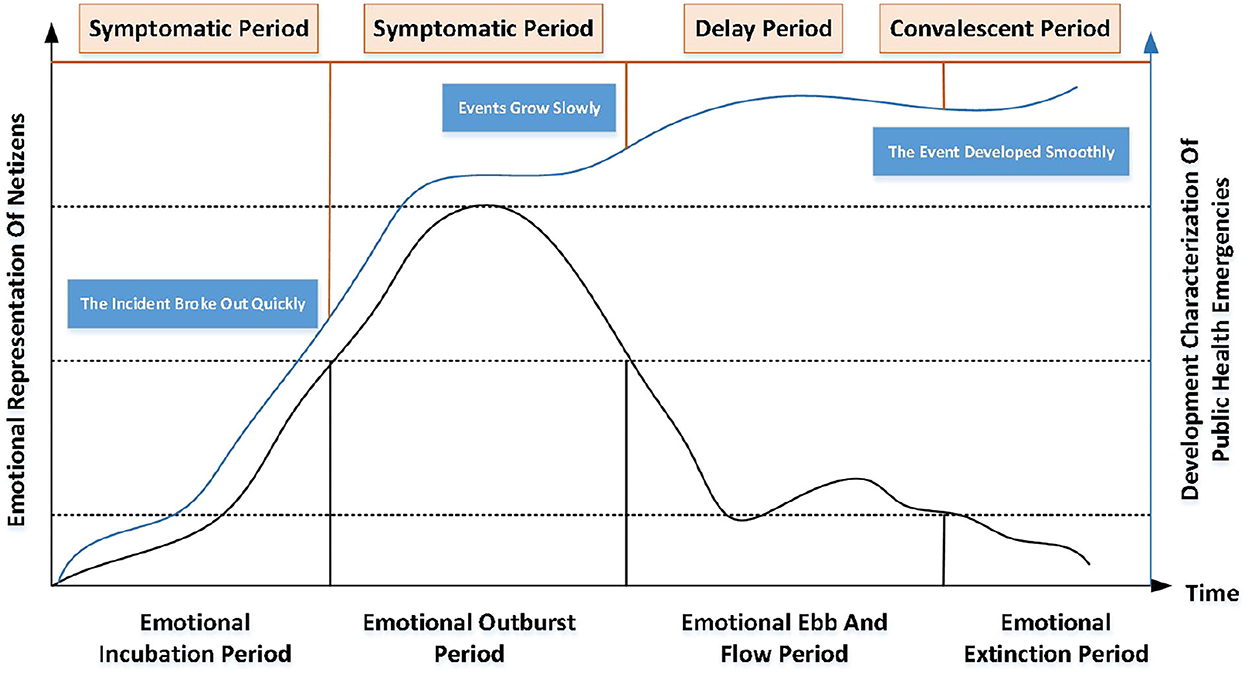
Figure 1. Evolution stage of public emergencies (Ren, K. et al., 2019).
The incubation period for netizens' emotions occurs after the public emergency begins to occur, when there is uncertainty about the nature, impact, and harm of the event, and when the public is unaware of the event. Therefore, bad emotions will gradually arise. However, due to the fact that the event is not widely known at this time, only a few netizens' on social media who are in the influence range of the event express relevant views, opinions, and comments. Therefore, the representation of netizens' emotion in the incubation period is very small.
However, with the rapid development of the incidence and the increase in the severity of public emergencies, information about them spread rapidly on social media, and more netizens' began to express their attitudes and spread information. As not only netizens' at the center of the incident but also those from other regions participate in the discussion of the incident, the overall panic of the netizens' starts to rise sharply into an outbreak of panic. The main reason for the beginning of netizens' emotional outbreak stage is that, due to the rapid outbreak of public emergencies, their wide spread makes netizens' emotional polarity (Ren, Z. et al., 2019). If the event itself does not break out quickly, then netizens' emotions will not enter the outbreak period and will gradually subside during the incubation period.
With the implementation of the government's prevention and control measures, the development of public emergencies began to slow down, the heat of online PO decreased, and PS began to decline through the highest point. Meanwhile, the increase in positive media reports reduced the uncertainty of information and rumors, and the public's understanding of the event was more accurate, where netizens' emotion was continuously reduced and began to enter the stage of emotional abatement. However, since the event is not completely over, some rumors or secondary events may spread on social media, so the panic mood may have certain volatility.
As shown in Figure 2, the development of public emergencies provides a stage for the critical change of netizens' emotions. The PO information in the social media environment provides the evolution of netizens' emotions, while the critical transformation characteristics of the system provide the criticality. Therefore, the evolution of netizens' emotions in the context of social media under public emergencies has the characteristics of stage, evolution, and criticality.
The identification of emotional critical points
According to the concept of critical points in a complex system (Truong et al., 2020), the concept of critical points can be expressed as follows when identifying the critical transition of time-series data: a token for time-series data of the system state , some sets of time points τ = {t1, t2, t3, …, tk} cause state changes in the sequence data at these positions and the time corresponding to these moments is called the critical point.
In a netizen emotion time series x = {x1, x2, …, xT}, the sequence x is assumed to be piecewise stationary, which means that some properties of the process change at some unknown time tk. It can be generally used to calculate the critical points and the actual data of the critical point of difference in addition to the sample for evaluation, namely, . When the number of samples T is infinite, the error of the critical point identification algorithm should be wirelessly close to 0 so as to satisfy asymptotic consistency.
We are not aware of the actual critical point of netizens' emotion under public emergencies, the possible optimal segmentation τ*, namely, the set of critical points, must be obtained by minimizing the quantitative criterion V(τ, x) (Truong et al., 2018).
Among them, c(.) is a loss function, which lies in the degree sequence of quantum on behalf of the goodness-of-fit of a specific model. The optimal split τ* is the set of optimal critical points for the minimum of the criterion V(τ). Depending on whether we know in advance the number of critical points k*. When the number of critical points is unknown, the critical point identification problem is to solve the following discrete optimization problem:
where pen(τ) is used to measure a proper division of the complexity of τ, namely, the penalty term.
Loss function c(.) is a measure of equilibrium. If after-segmentation subsequence is homogeneous, which means that it does not contain any critical points, then c(xta·tb) should be smaller; if the child signal is heterogeneous, it means that it contains one or more critical points, then c(xta·tb) should be larger. Model drift, which is in response to changes in the statistical properties of the predictor variables, is adopted to prevent model training failures caused by changes in the underlying variables. For example, patterns in the data change due to seasonality. The loss function can be calculated as follows:
Among them, is the empirical covariance matrix of the subsequence.
Emotion analysis model based on topic clustering
The topic discovery model based on the topic model combined with the hierarchical clustering algorithm is a fusion of the LDA algorithm and the BC-BIRCH algorithm. The topic model framework of PO in the microblog for public emergencies is shown in Figure 3.
Calculation of emotional intensity
First, for the sentence that contains emotion, we divided it into two parts. When the emotional words were found, it was checked whether there were degree adverbs and negative words before and after the emotional words. At the same time, the degree level of degree adverbs and the number of negative words should be considered. Finally, the emotional polarity value of the microblog text can be obtained by calculating the emotional polarity of a single sentence (Wu et al., 2021).
Text segmentation is the process of dividing every clause into single words according to certain rules, which is a key step in semantic understanding. In this paper, we used Jieba word segmentation toolkit in Python for Chinese word segmentation and retreived the data set after the word segmentation. Stop words refer to the words or words that have no real meaning for the follow-up work and the theme is not obvious, such as modal particles and special symbols. The comprehensive polarity weight of a sentence in the microblog text is used to judge the role of a single sentence in the text. The microblog text T is defined as being composed of several sentences Y, T = {Y1, Y2, …, Yn}, and then the sentiment value P(Yi) of a single sentence Y1 is calculated to obtain the sentiment polarity value P(Y) of T from the sentiment value of a single sentence, as shown in Formulas (4) and (5):
where Yw is the sentiment value of the sentiment word Wi in a sentence. If P(Y) is >0, it means that the microblog is positive emotion. If P(Y) is < 0, it means that the microblog is a negative emotion. While if P(Y) is equal to 0, it means that the microblog is neutral emotion.
Several sentences in the microblog text can be expressed by five sentence patterns: declarative sentence, rhetorical question, interrogative sentence, exclamatory sentence, and hypothetical sentence. Sentence patterns also affect the emotional value of a single sentence. For example, the emotional attitudes of the same sentence expressed by declarative and interrogative sentences are quite different. is defined as the sentiment value of a single sentence in the microblog after considering the sentence pattern characteristics (Yang, 2020). The sentiment value calculated by different sentence patterns is shown in Formulas (6)–(9):
Considering that the number of microblog comments will gradually decrease in the later stage of PO evolution, which may also lead to large emotional variance, this paper defines the formula of emotion hot as follows:
In Formula (10), D is emotional heat, M is the number of comments, and P is the variance of affective propensity. Minmax is the standardized processing method. By standardizing the number of comments, we can avoid the problem of large emotional variance caused by the small number of published comments and make the two indicators of the number of comments and the variance of emotional tendency better perform in the analysis model of emotion evolution.
The BC-BIRCH clustering algorithm
Aiming at the defects of the BIRCH algorithm, the BC-BIRCH algorithm is proposed. The core idea of the algorithm is to combine related topics into a cluster as much as possible so as to reduce the number of clusters and to improve the accuracy of clustering. The algorithm process is shown in Figure 4.
The BC-BIRCH algorithm is an improvement of the BIRCH hierarchical clustering algorithm. The BIRCH algorithm has certain defects, that is, when a new data node needs to be inserted, the algorithm needs to calculate the distance between the new node and other leaf nodes, select the cluster with the shortest distance, and then merge and compare the diameter of the merged cluster with the threshold. If the diameter of the merged cluster is greater than the threshold value, the algorithm can calculate the distance between the new node and other leaf nodes. The new data point is split into a single cluster. In addition, the initial threshold value of the diameter threshold is fixed at the beginning of the algorithm, which can be tuned by continuous testing. In the process of inserting a new data node, the node is close to the center of the nearest cluster, but when the new node is merged with the cluster, the diameter of the merged node is greater than the threshold, which results in the new data node separated from the cluster as a single cluster. Finally, data from similar nodes cannot be combined well and the number of split clusters is too much, which leads to low clustering accuracy (Wang and Zhang, 2020).
The steps of BC-BIRCH are as follows:
Step 1. Initialize an empty tree and insert the first sample into the root node.
Step 2. Calculate the distance between the new sample and each child node of the node, iterate repeatedly to find the cluster with the smallest distance from the new sample, and continue if the radius is less than the threshold. Otherwise, the cluster with the shortest distance from the first merged cluster is found and merged to calculate the radius. If the radius is less than the threshold, it will be merged. If all the radiuses after merging are greater than the threshold, it will be regarded as a single cluster.
Step 3. If the number of CloudFlare (CF) nodes of the current leaf node is less than the threshold, create a new CF node, insert the new data, and then put the new CF node into the leaf node, update all CF nodes in the path, and the insertion is finished.
Step 4. Otherwise, the current leaf node is divided into two new leaf nodes. Among all CF tuples in the old leaf node, the hypersphere distance of any two CF tuples is calculated, and the two CF tuples with the farthest distance are selected and put into two new leaf sub-nodes, respectively, to calculate other tuples and new sample tuples.
Experiment and analysis
Data acquisition
Microblog text data were collected at https://www.sina.com.cn/. Different keywords such as “COVID-19” and “Epidemic” were input. Each search result includes 50 pages of data, and each page has 20 microblogs, that is, 1,000 pieces of data. Therefore, in this study, the required time window was segmented to achieve all relevant microblog content searches. Then, using the web crawler technology, the Sina API interface was called to crawl all the microblog contents on the page.
A comparison of the topic clustering effect
In this paper, silhouette coefficient (Si) (Rezanková, 2018) was used to determine the number of clustering topics. If the number of clustering topics K is too small, the data itself will not be separated, which will affect the clustering effect. However, as the number of topics K increases, the value of Si will become smaller and smaller, and the clustering effect will become worse and worse. To verify the effectiveness of clustering results, the K-means, BIRCH, and BC-BIRCH algorithms used in this paper were selected for experiments. The comparison results are shown in Figure 5.
It can be seen from the comparison results that, when the BC-BIRCH algorithm is selected, and K = 5, Si has an optimal value, which is 0.55. At the same time, the clustering effect of the BC-BIRCH algorithm is the best under the same topic number. Therefore, the number of clustering topics is 5. In addition, the clustering effect of different topics is shown in Figure 6.
As can be seen from Figure 6, the clustering effect of topics A and C is better.
Evolution trend of PS
As shown in Figure 7, the emotional fluctuation of netizens' in the initial stage of PO under different themes is relatively large, where A–E represent different hot public emergencies. It is not easy to be affected by people's emotions. However, with the passage of time, after the official microblog announced the processing results, netizens' emotions gradually tended to be stable, and their emotions mostly turned from negative to positive. It can be concluded that each time the official government media publishes a microblog to explain, it will stimulate the enthusiasm of netizens' to participate in the discussion. In addition, official response behavior plays an important role in PO communication and is an important factor to stimulate the development of PO. Different response contents from official government media may lead to different PO trends. Therefore, relevant management departments should focus on the supervision and intervention of PO, and release authoritative explanations quickly and pertinently so as to avoid the adverse impact of erroneous and extreme PO on society.
Analysis of the evolution of PS
As mentioned earlier, topic A (COVID-19 event) with the best clustering effect was selected to verify the evolution analysis of PS.
The two critical points identified by this model are the boundaries, and the overall evolution of netizens' panic under the COVID-19 epidemic event during the study period is divided into three parts. According to the critical transition diagram in the evolution of PS (Figure 8), it can be seen that the two critical points divide the evolution of internet users' panic emotion under the COVID-19 epidemic event into three parts, and the overall variance change of internal emotions in each part is balanced. However, there is a big difference in the mean value (horizontal line) between all parts (among which the average value of stage 1 is 58.596, the average value of stage 2 is 782.715, and the average value of stage 3 is 374.689). It can be seen that, in the burst phase, the curve changes are more fluctuating and the jump between the peaks is more significant. Therefore, it can be concluded that there is a critical change of netizens' emotion under public emergencies.
In addition, the location of each critical point represents the change in the overall emotional state of netizens', that is, the occurrence of a critical transition. Critical point 1 represents the transition of PS from a low level of stable development to the state of a rapid increase of high outbreak under the new outbreak. Critical point 2 indicates the transition of netizens' emotion from a highly explosive and rapid growth state to a state of medium-level slow development. According to the life cycle model of netizens' emotions, we can regard these three periods as the three stages of netizens' emotions, namely, the emotional incubation period, the emotional outbreak period, and the emotional fluctuation subside period, which is roughly consistent with the previous stage analysis of netizens' emotions during public emergencies.
Figure 9 shows the model prediction results of the critical transition of PS.
In both positive and negative critical transitions, the predicted critical point is consistent with the actual critical point, and the predicted critical point and actual critical point are in the same position, which can accurately predict the occurrence of critical transition of netizens' panic emotion. In addition, it can be found that, in the reverse phase, the critical point predicted by the PS evolution model is two-time points ahead of the real critical point, but it is also close to the original critical point.
Conclusion
Due to the uncertainty and harmfulness of public health emergencies, they will have a serious impact on public physical and mental health and on social and economic development. First, based on the concept of critical points in a complex system, this paper proposes an algorithm to identify the critical points of PS based on microblog data analysis. The BC-BIRCH algorithm is used to cluster the topics of public emergencies and then the evolution model of PS under public emergencies is established. The experiment verifies an excellent clustering effect of the BC-BIRCH algorithm and selects the topic A event with the best clustering effect to analyze the evolution of PS. The results show that under this topic, the evolution of PS can be divided into emotional incubation period, emotional burst period, and emotional fluctuation fading period. Meanwhile, the credibility of official government media has a direct impact on the emotional polarity of netizens', which is helpful for relevant departments to obtain more in-depth information and solutions in PO events, and to provide suggestions for government departments in the management and decision-making of PO.
This study provides directions and strategies for the government and relevant departments to guide PS and manage emotional emergency. In the whole stage of public health emergencies, both the government and the media should reduce the risk and uncertainty of the event and reduce the harm caused by the public's emotions to society by suppressing the overall outbreak of internet users' emotions or promoting the transition of internet users' emotions to the fading period. However, due to the problem of the time span of the case data, only two critical points, namely, three evolution stages, were identified, while the extinction period of the evolution of panic among netizen was not identified. In the future, data samples with a longer time span can be selected to identify and analyze all critical points in the development of events. Therefore, in future research, more algorithms can be selected for comparison and verification, and different cases can also be studied experimentally to find the best model for internet users' emotion prediction under public health emergencies.
Data availability statement
The original contributions presented in the study are included in the article/supplementary material, further inquiries can be directed to the corresponding author.
Author contributions
ZP contributed to writing—original draft preparation and data collection. HF contributed to data preprocessing and design of methodology. Both authors contributed to the article and approved the submitted version.
Funding
This work was supported by the Hubei Provincial Natural Science Foundation of China: Research on Customer Satisfaction Mining Based on Big Data, the Project Number is ZRMS2019001565.
Acknowledgments
We thank reviewers whose comments and suggestions helped to improve this manuscript.
Conflict of interest
The authors declare that the research was conducted in the absence of any commercial or financial relationships that could be construed as a potential conflict of interest.
Publisher's note
All claims expressed in this article are solely those of the authors and do not necessarily represent those of their affiliated organizations, or those of the publisher, the editors and the reviewers. Any product that may be evaluated in this article, or claim that may be made by its manufacturer, is not guaranteed or endorsed by the publisher.
References
Dong, X., Lian, Y., and Tang, X. (2020). The damped oscillator model (DOM) and its application in the prediction of emotion development of online POs. Expert Syst. Appl. 148, 113268. doi: 10.1016/j.eswa.2020.113268
Fang, S., Zhao, N., Chen, N., Xiong, F., and Yi, Y. (2019). Analyzing and predicting network public opinion evolution based on group persuasion force of populism. Phys. A Stat. Mech. Appl. 52, 809–824. doi: 10.1016/j.physa.2019.04.054
Gu, X., Cai, W., Gao, M., Jiang, Y., Ning, X., and Qian, P. (2022). Multi-Source Domain Transfer Discriminative Dictionary Learning Modeling for Electroencephalogram-Based Emotion Recognition. IEEE Transactions on Computational Social Systems. doi: 10.1109/TCSS.2022.3153660
Haro-de-Rosario, A., Sáez-Martín, A., and del Carmen Caba-Pérez, M. (2018). Using social media to enhance citizen engagement with local government: Twitter or Facebook? New Media Soc. 20, 29–49. doi: 10.1177/1461444816645652
Hassan, M. K., Hudaefi, F. A., and Caraka, R. E. (2022). Mining netizen's opinion on cryptocurrency: sentiment analysis of Twitter data. Stud. Econ. Finance 39, 365–385. doi: 10.1108/SEF-06-2021-0237
Jiang, F., Cui, A., and Liu, Y. (2013). “Every term has sentiment: learning from emoticon evidences for Chinese microblog sentiment analysis,” in Natural Language Processing and Chinese Computing (Berlin: Springer), 224–235.
Ma, W. (2022). Governance of government microblog network PO from the perspective of social safety valve. News Forum 36, 67–69.
Ren, K., Wu, D., and Guo, L. (2019). Research on public crisis PO events based on life cycle theory. Modern Inform. Technol. 3, 1–4. doi: 10.19850/j.cnki.2096-4706.2019.24.001
Ren, Z., Zhang, P., Liu, J., and Lan, Y. (2019). Research on netizens' emotion evolution in emergency based on machine learning. J. Phys. Conf. Ser. doi: 10.1088/1742-6596/1419/1/012004
Rezanková, H. (2018). “Different approaches to the silhouette coefficient calculation in cluster evaluation,” in 21st International Scientific Conference AMSE Applications of Mathematics and Statistics in Economics (Kutná Hora), 1–10.
Rong, H., Ma, T., and Cao, J. (2019). Deep rolling: a novel emotion prediction model for a multi-participant communication context. Inf. Sci. 488, 158–180. doi: 10.1016/j.ins.2019.03.023
Rui, T., Cui, P., and Zhu, W. (2017). Joint user-interest and social-influence emotion prediction for individuals. Neurocomputing 230, 66–76. doi: 10.1016/j.neucom.2016.11.054
Ruz, G. A., Henríquez, P. A., and Mascareño, A. (2020). Sentiment analysis of Twitter data during critical events through Bayesian networks classifiers. Future Gener. Comput. Syst. 106, 92–104. doi: 10.1016/j.future.2020.01.005
Saputri, M. S., Mahendra, R., and Adriani, M. (2018). “Emotion classification on indonesian twitter dataset,” in 2018 International Conference on Asian Language Processing (IALP), (Bandung: IEEE), 90–95.
The 13th Five Year Plan for the Construction of National Emergency Response System. Available online at: http://www.gov.cn/zhengce/content/2017-7/19/content_5211752.htm (accessed August 19 2017).
Truong, C., and Oudre, L, Vayatis, N. (2018). Ruptures: change point detection in Python. arXiv [Preprint]. arXiv:1801.00826.
Truong, C., Oudre, L., and Vayatis, N. (2020). Selective review of offline change point detection methods. Signal Process. 167, 107299. doi: 10.1016/j.sigpro.2019.107299
Wang, A., and Zhang, J. (2020). “Topic discovery method based on topic model combined with hierarchical clustering,” in 2020 IEEE 5th Information Technology and Mechatronics Engineering Conference (ITOEC), (IEEE), 814–818.
Wu, D., Yang, R., and Shen, C. (2021). Sentiment word co-occurrence and knowledge pair feature extraction based LDA short text clustering algorithm. J. Intell. Inf. Syst. 56, 1–23. doi: 10.1007/s10844-020-00597-7
Wu, J., Guo, P., Cheng, Y., Zhu, H., Wang, X., and Shao, X. (2020). Ensemble generalized multiclass support-vector-machine-based health evaluation of complex degradation systems. IEEE/ASME Trans. Mechatron. 25, 2230–2240. doi: 10.1109/TMECH.2020.3009449
Yang, J. (2020). Analysis and evolution of internet users' emotional tendency in emergencies. Xiangtan University.
Zeng, L., and Li, R. (2022). Construction safety and health hazard awareness in Web of Science and Weibo between 1991 and 2021. Safety Sci. 152, 105790. doi: 10.1016/j.ssci.2022.105790
Zeng, L., Li, R. Y. M., Mao, Y., Chen, H., and Zeng, H. (2022). A comparative study on Linkedin and Sina Weibo users' perceptions of the carbon-neutral city. Front. Environ. Sci. doi: 10.3389/fenvs.2022.962367
Keywords: social media, public emergencies, BC-BIRCH, critical point, emotional evolution
Citation: Pi Z and Feng H (2022) The evolution of public sentiment toward government management of emergencies: Social media analytics. Front. Ecol. Evol. 10:1026175. doi: 10.3389/fevo.2022.1026175
Received: 23 August 2022; Accepted: 15 November 2022;
Published: 08 December 2022.
Edited by:
Rita Yi Man Li, Hong Kong Shue Yan University, Hong Kong SAR, ChinaCopyright © 2022 Pi and Feng. This is an open-access article distributed under the terms of the Creative Commons Attribution License (CC BY). The use, distribution or reproduction in other forums is permitted, provided the original author(s) and the copyright owner(s) are credited and that the original publication in this journal is cited, in accordance with accepted academic practice. No use, distribution or reproduction is permitted which does not comply with these terms.
*Correspondence: Hao Feng, MTExMDk3OTdAcXEuY29t
 Zhongxu Pi1
Zhongxu Pi1 Hao Feng
Hao Feng